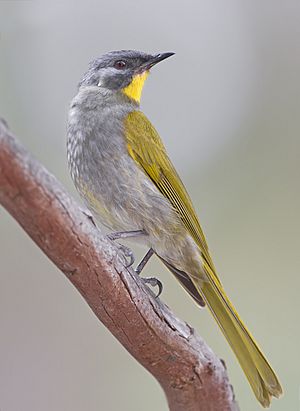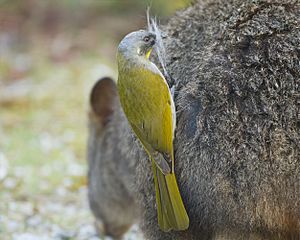Yellow-throated honeyeater facts for kids
Quick facts for kids Yellow-throated honeyeater |
|
|---|---|
 |
|
| Conservation status | |
| Scientific classification | |
| Genus: |
Nesoptilotis
|
| Species: |
flavicollis
|
| Synonyms | |
|
Lichenostomus flavicollis |
|
The yellow-throated honeyeater (Nesoptilotis flavicollis) is a type of passerine bird. It belongs to the honeyeater family and lives only on the island of Tasmania in Australia. This bird looks and acts a lot like the white-eared honeyeater. Long ago, people sometimes thought of it as a problem for fruit farms.
Contents
About Its Name
Scientists give every animal a special name. The yellow-throated honeyeater was first described by a French bird expert, Louis Jean Pierre Vieillot, in 1817. He gave it a scientific name that comes from Latin words: flavus means 'yellow', and collis means 'neck'. So, its name literally means "yellow-necked."
People also call this bird by other names, like the green cherry-picker, green dick, or green linnet.
This bird used to be in a different group of birds called Lichenostomus. But in 2011, scientists studied its DNA and found it fit better in the group Nesoptilotis. It is closely related to the white-eared honeyeater (N. leucotis), which lives on mainland Australia.
What It Looks Like
The yellow-throated honeyeater is a medium-sized bird with a fairly long tail. It usually weighs about 31 g (1.1 oz) and is about 21 cm (8.3 in) long.
Its feathers are bright olive-green on its back. Its head, face, and belly are silver-grey. A bright yellow patch on its chin and throat stands out. It also has a small yellow spot near its ear, and the edges of its wing feathers are yellow. Its beak is black, and its eyes are a deep ruby red. Female birds are a bit smaller than males. Young birds look very much like adults, but their colors are not as bright.
Where It Lives
The yellow-throated honeyeater is common and can be found all over mainland Tasmania. It also lives on King Island and the Furneaux Group of islands. This bird is not considered to be in danger.
It likes to live in temperate forests, woodlands, and areas with coastal bushes and plants. It prefers both wet and dry sclerophyll forests, but you can also find it in other places. These include alpine eucalypt woodlands, cool rainforests, and coastal heathlands. Sometimes, they even visit places where people live, like golf courses, fruit farms, parks, and gardens.
How It Behaves
Yellow-throated honeyeaters are quite protective of their space. They can be a bit aggressive towards other honeyeaters, pardalotes, golden whistlers, and grey shrike-thrushes. They will chase these birds away from their territory.
What It Eats
This honeyeater mostly eats arthropods, which are like insects and spiders. It also drinks some nectar from flowers and sometimes eats fruit or seeds. They look for food from the tops of trees all the way down to the ground. They usually hunt alone or in pairs.
They find food by looking on tree trunks, branches, and the ground. They also poke their beaks into loose bark on tree trunks. Sometimes, they fly out to catch insects in the air. Less often, they check flowers for insects or nectar.
Life Cycle and Reproduction

Yellow-throated honeyeaters build nests and raise their young from August to January. During this time, female birds move into the male birds' territories.
The nest is often built low to the ground, usually less than 1 m (3.3 ft) high, in a small bush or clump of grass. But sometimes, they build nests up to 10 m (33 ft) high in tree leaves. The female builds the nest using grass, bits of bark, leaves, and spiderwebs. She lines it with soft materials like treefern fibers, wool, and animal fur. These birds are known for collecting hair for their nests from live animals, such as horses, dogs, and even humans!
The female bird lays two or three pinkish eggs. She sits on the eggs to keep them warm for about 16 days until they hatch. She also feeds the baby birds once they hatch. The young birds stay in the nest for about 16 days. When the young birds are old enough to leave the nest (around three weeks old), the male bird will chase them and the female away.
Sometimes, other birds called fan-tailed cuckoos and pallid cuckoos lay their eggs in the yellow-throated honeyeater's nest. This means the honeyeater ends up raising the cuckoo's babies instead of its own.
Its Calls
The yellow-throated honeyeater makes many different sounds. One call is used during breeding season to attract mates and show other birds that this is their territory. This call sounds a bit different depending on where the bird lives, but it's usually a whirring chur-uk, chur-uk or a loud de-wit.
Another common sound they make is a repeated tonk, tonk, tonk or tchook, tchook.
See also
 In Spanish: Mielero cuelligualdo para niños
In Spanish: Mielero cuelligualdo para niños


